A curious disc-like object pouring smoke and hovering over buildings was recently found in a monastery wall painting believed to date to the 16th century; the image is painted in a 14th century church in Sighisoara in Romania.
The photograph (below), taken by tourist Catalina Borta, is perceived by some to be a centuries-old depiction of a UFO.
The image in the Romanian monastery painting certainly does look like a classic UFO; if that’s what it was intended by the original artist to depict, it wouldn’t be the first surviving old-world depiction of what many mistakenly think to be a relatively modern phenomenon. There are numerous well-known medieval depictions, as well as much older images (and of course descriptions in ancient or classical texts, including several oft-referenced Bible passages) thought by many to be plausible references to UFOs or ‘alien visitations’.
Apparent references to UFOs or flying saucers also exist in primitive rock paintings, the art and sculpture of ancient South-American civilisations, Sumerian and Mesopotamian folklore (or history) and archaeological curiosities, Ancient Egyptian art and hieroglyphs, medieval tales, and more.

Acknowledgement of this mystery – and of how far back across human culture the UFO phenomenon appears to extend – is a big deal: it in fact forces us to reevaluate our understanding of history. Because these anomalies staring us in the face seem to confirm that the UFO mystery and even the flying saucer business is not a modern fascination linked to our technological age, and nor did it begin in the 1940s.
Let’s start with classic paintings: because these are arguably the most tantalising of all.
There are several examples of ancient UFOs in religious paintings, including paintings depicting The Crucifixion. What’s most interesting about these items is that the artists in question, we have to assume, were trying to incorporate subtle or coded message into their works. And the question we have to ask is what the message is – and why these artists bothered to incorporate them in the first place.
I’m going to admit, in fact, that the first time I became aware of and interested in this strange business of the various paintings, I did almost wonder if there was something very ‘Mandela Effect’ about this. What I mean by that is that the cultural reality or awareness of these specific paintings and their strange details didn’t seem to exist until roughly a few years ago. Maybe it did and I just wasn’t aware of it. But it certainly felt like one day these paintings didn’t exist and were never talked about: and then all of a sudden they did exist and were being drawn attention to.
If they always did exist, it’s strange that they took so long to be noticed – or to be talked about in these terms. And, yes, I’m going to assume they always did exist: I apologise for the tangent, but there honestly was a Mandela Effect type feeling I had about these paintings at first, that’s all.
A painting titled simply “The Crucifixion” (by an unknown artist in 1350) seemingly depicts two UFOs with actual beings inside them: the objects are flying by the scene of Jesus’s crucifixion in the top right and left corners of the painting.


The fact that this distinctly strange take on the crucifixion is attributed to an unknown artist makes it all the more intriguing. Why is the artist anonymous? The detail of living beings being clearly shown inside the flying objects is the key: without the ‘pilots’, you could argue the objects were meant to be celestial phenomena like comets or shooting stars.
Or maybe they were meant to be angels: but angels are and were generally depicted as winged and never – so far as I know – being contained within objects. Of all the many depictions of angelic beings in religious paintings, this seems to be the only one that depicts them in this way. It is possible, perhaps, that the artist is simply anthropomorphising ideas like comets or stars by merging them with human or humanoid forms – but, again, it looks very much like the beings are *inside* the objects and even flying them.
As it is, we have to ask what the artist was trying to say here – and why he included these very curious details in a depiction of Jesus’s crucifixion. Are the ‘pilots’ meant to be significant to the event itself of Jesus’s crucifixion – or are they simply passing by by sheer chance?
“The Madonna with Saint Giovannino” is a painting from around the 15th century most likely painted by Domenico Ghirlandaio. The painting depicts Mary, the mother of Jesus, looking down, while in the background we see what strongly appears to be a UFO flying above.
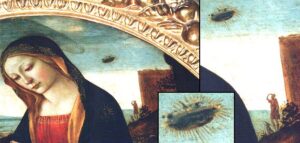
Meanwhile, the painting’s most striking or curious feature is a man in the background, who appears to be blocking the sun with his hand while he gazes up at the strange object in the sky. This figure in the background is clearly paying attention to the anomalous sight in the sky. Why did the artist include this secondary narrative in the background?
Why did he bother showing an anonymous figure in the background at all, let alone looking up at a UFO? Again, the anomalous sky object and its witness don’t seem to be connected to the painting’s central focus or theme: that of the Madonna. Instead they seem like almost incidental details: as if someone – in modern day terms – took a photo with a camera and accidentally caught this other thing happening in the background.
But, of course, the artist in this case wasn’t taking a photo: and this type of painting took a long time to carry out, with the artists’ engaging in painstaking attention to detail – the man in the background and the object in the sky were put there for a reason. The question, again, is why.
In a painting titled “The Baptism of Christ”, painted in 1710 by Aert De Gelder, you can definitely see what seems like an otherworldly craft shining its light down on the Jesus figure.
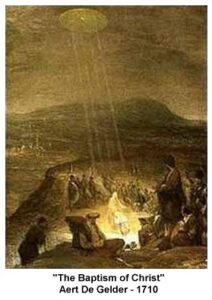
It could be interpreted as God or a Godly being such as an angel, perhaps: but its uncanny resemblance to a typical UFO space craft or flying saucer cannot be ignored or dismissed. For some reason, the Dutch artist has replaced the common motif in regard to Jesus’s baptism in the Jordan River, which would be of the dove (of the Holy Spirit) or the light of God from heaven – and has replaced it with something that clearly looking like what we would today say is a flying saucer.
But this was a few hundred years before the first reported modern sightings of flying saucers in the 1940s. And the historic or religious event the artist is depicting is obviously two-thousand years earlier. You might be able to argue the saucer-like appearance is just coincidental (through our modern lens) and that this was simply the artist’s visual interpretation of a divine light from the heavens.
But… boy, it really does look both saucer-shaped and metallic.
In the epic painting called “The Annunciation” (from 1486 and by Carlo Crivelli), there seems to be an image of a UFO beaming down light towards the building and through a window into the head of the figure representing Mary.

This is actually one of my favorite paintings of all time: just for how engaging the scene is, how many elements and details there are and how much symbolism seems to be placed all over the image. In this particular image, I’m actually more open to the interpretation that the object in the sky might not be a UFO or physical object: but could simply be the artist’s vision of the power of God or the Holy Spirit connecting to Mary from the heavens. It’s still very interesting though.
Also, there doesn’t appear to be any depiction of the Angel Gabriel in this painting, which is curious, as Gabriel is meant to be a key figure in the annunciation.
“The Annunciation” now hangs in the National Gallery, London.
“The Miracle of the Snow” is one of the most extraordinary. This painting from 1388-1440 was by Masolino Da Panicale and currently is housed at the church of Santa Maria Maggiore in Florence. While it depicts the risen Jesus and someone else (I’m not sure if it’s meant to be Mary or one of the disciples like Peter) appearing in the sky over a congregation, there’s clearly something very odd about how this idea is depicted.
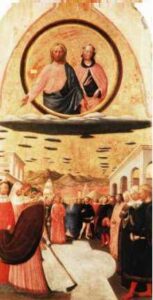
Because it really does look like Jesus is riding with a fleet of UFOs or flying discs. Why are there so many of them? What’s the message supposed to be?
There are other examples out there, but I’m going to limit it at this point: as the general idea – the anomalous nature of these classical paintings – has been established here by now. In all of these above-mentioned cases, the UFO-like imagery seems clear and obvious: and also in all of these instances the primary or surface-level theme or focus of the work is religious and specifically Christian.
However, if we assume that the artists in these instances were deliberately incorporating subtle messages in these works, that wouldn’t necessarily mean they were linking the UFOs to Christian or religious beliefs or dogmas. Given the dates of these various works, and given the dominance of Christianity and the church in European culture and society, the majority of major works of art were essentially Christian in nature.
If we do make the argument that these artists were putting hidden or subtle message into these works, then the likelihood would be that they were simply using the opportunity to subtly point to the existence of this phenomena or mystery. The church – and the artists’ various patrons – may not have allowed them to produce anything that was openly exploring or depicting flying saucers, UFOs or aerial anomalies: and so the only the way they could do it was by stealth, essentially sneaking these ‘easter eggs’ into their work and leaving these oddities there for anyone able to notice them.
Certainly, the idea of artists hiding hidden or secret details or meanings in their work isn’t outlandish: it seems to be generally accepted, for example, that Leonardo Da Vinci had a tendency to do such things.
And, hell, there’s a whole school of thought to suggest that even the Gospels were written in code – with a surface layer text and story designed for one audience and a hidden, coded narrative in the same text for another audience: the Pesher Code technique was popularised by Barbara Thierring, for example, and she makes a very strong case for the reality of a coded version of Jesus’s story being structured into the gospel texts for an initiated audience.
But – if this is what’s going on in these paintings – it does raise the bigger question: just how far back in history does this UFO phenomenon go?
And how widespread was knowledge of it? If these artists in these cases knew about – or had seen – UFOs or strange objects in the sky, then it implies lots of other people probably had too.
So what was the general public perception of these matters? And what was the church position on the matter? What did people think they were? Visitors from outer space? Angels? Gods? Signs from the Almighty? The apparent fact that we don’t seem to have a lot of known historical or textual evidence of UFO-type activity or encounters from these periods in history would, on the surface of it, suggest they were not common: however, why would several artists be apparently depicting such things in their works if these kinds of things weren’t at least somewhat common or at least known about?
In fact, while they have tended to be mostly glossed over by mainstream history, there are a number of historical texts or accounts seeming to record UFO-type events or encounters.
Let’s talk, for example, about what apparently occurred in Nuremburg on the 14th April 1561. Residents in Nuremberg apparently saw what they described as an aerial battle, followed by the appearance of a large black triangle object and then a large crash outside of the city. According to the witnesses, there were hundreds of spheres, cylinders and other odd-shaped objects that were in the sky above them.

This was apparently a well recorded event, appearing in a newspaper and depicted in a woodcut by Hans Glasser. Given the tangible historical items of evidence, this is arguably the best historical UFO event story we have. Elsewhere, in an apparent UFO sighting over Hamburg on 4th November 1697, the mystery objects were described as “two glowing wheels”.
It isn’t necessarily a stretch to think that a mass witnessed event like the one in Nuremberg might have a lasting impact on folklore and even beliefs: so that plenty of people who might see the apparent UFO object in, for example, Ghirlandaio’s painting of the Madonna, would have a decent idea of what it was depicting. Granted, most of the paintings detailed above pre-date the Nuremberg incident (some of them by centuries); but we don’t know how many similar incidents to Nuremberg might’ve occurred in earlier centuries but not been recorded.
For example, there are accounts given in ancient writings that, arguably, could be seen to depict UFO-type events: including by Roman writers like Livy, Plutarch and Josephus. In Josephus’s case, the Jewish historian appeared to describe ‘flying chariots’ and ‘armed battalions’ being seen in the skies over Judea: and prefaces his account with the admission that the account ‘would, I imagine, have been deemed a fable, were it not for the narratives of eyewitnesses…’
Plutarch, likewise, gave an account of a ‘wine jar’ shaped object descending from the sky with a form like ‘molten silver’, during a Roman assault on the forces of King Mithridates VI in 74 BC. While a sceptic might argue in a case like this that any descriptions of objects appearing in or descending from the sky would be a reference to gods or demi-gods, this would be an odd thing for a historian of Plutarch’s stature to engage in: and, also, wouldn’t ancient writers specify or name the gods or demi gods they were trying to evoke?
Why would Plutarch instead describe a ‘wine shaped’ object of ‘molten silver’? That doesn’t sound like a colorful metaphor: it sounds very specific and very plain – and not an allusion to something mythological.
Clearly then, there are accounts and mysteries going back all the way through history: Plutarch and Josephus were roughly contemporary to Jesus and the Gospel period, but the anomalies, easter eggs and strange accounts go back much further than that. To the Egyptians, for example, as well as to Old Testament references (the ‘chariots of fire’ and Ezikiel’s strange humanoid creatures) and Mesopotamian culture.
In fact, there might not be a culture on earth that hasn’t at some point been touched by these types of phenomena: everyone from various Native American tribes to African tribes like the Dogon in Mali to the ancient Hindu scriptures and myths, all seem to have strange items in their mythologies – or even tangible items in their archaeology and artifacts – that seem to suggest a common mysterious phenomena spanning times and cultures.
Whatever these things. these UFOs, are – whether they’re from elsewhere in the universe, or whether they’re interdimensional or whether they’re something else entirely – the evidence seems to be that they’ve been here for a very long time.
Evidently, the prevailing mainstream consensus of history isn’t the complete picture: there are cracks, anomalies and puzzles in that perceived history of human civilisation and life on earth. Maybe some of those Renaissance artists and painters were aware of that problem and were trying to send everyone a subtle hint in that direction.

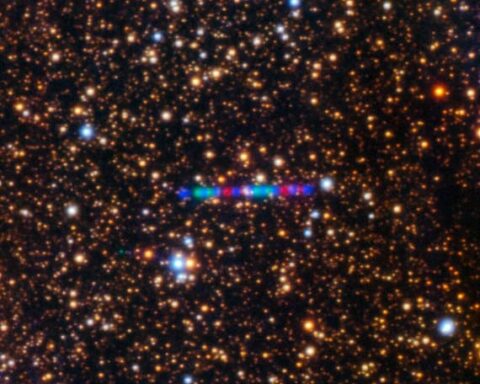
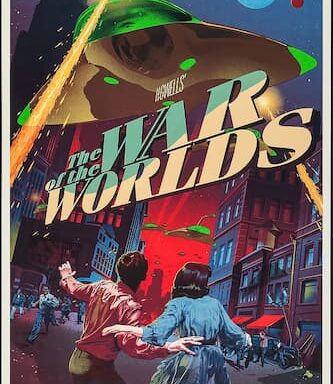


This is the subject matter in the 3rd book from my ‘AfterLife’ series. The 1st & 2nd, ‘House Guests and Ghosts’ & ‘Signs; From Beyond the Grave’ are on Amazon and Kindle. I’m a writer and an art major. The UFO depictions have been discussed every time one of the paintings is shown, with all agreeing that the artist doesn’t paint without purpose. Extraterrestrial depictions show what they saw, and have been seen as far back as far as prehistoric times. I delve into that and much more in my next book. I thoroughly enjoyed your insightful piece. Thank you- Susan Mariani
Thanks Mariani. Your books sound really interesting.
certainly a subject worth the eighth pillar of wisdom, Lawrence. Myths, legends, holy books and visual interpretations are not born of nothing. Since I started to to see the truth about human civilization (just a self-study) there has been a strong “pull” towards the what we call “heavens” or “cosmos” or space. And India 🙂 Staunch atheist BTW.
What do you think about the ‘orbs’ and stuff being seen in the sky lately?
they have always been here, above and underground. we are just mere spectators to great mysteries. we know nothing from our real past, it has been kept secret from us yet, I believe, I have an open mind to all possibilities. great riting, loved it, thanhs.
It’s a fascinating matter to ponder.